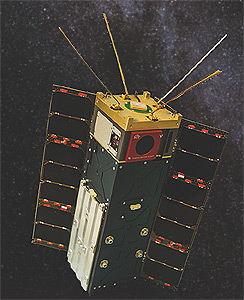Thank you very much for visiting Gunter's Space Page. I hope that this site is useful and informative for you.
If you appreciate the information provided on this site, please consider supporting my work by making a simple and secure donation via PayPal. Please help to run the website and keep everything free of charge. Thank you very much.
HARP

HARP [SDL]
HARP (HyperAngular Rainbow Polarimeter) is a mission conducted by the Department of Physics, University of Maryland, Baltimore County, to measure the microphysical properties of cloud water and ice particles.
HARP is a precursor for the new generation of imaging polarimeters to be used for the detailed measurements of aerosol and cloud properties. The HARP payload is a wide FOV imager that splits three spatially identical images into three independent polarizers and detector arrays. This technique achieves simultaneous imagery of three polarization states and is the key innovation to achieve high polarimetric accuracy with no moving parts.
The HARP CubeSat mission is a joint effort between UMBC, the PI institution, who will provide the sensor hardware and characterization and scientific analysis; the Space Dynamics Laboratory – Utah State University, who will provide the 3U CubeSat spacecraft and mission operations; and Science and Technology Corp, who will lead the science algorithm development and science application funded by NOAA. NASA Wallops will support instrument environmental testing, mission operations, and communications. The program is in support of the NASA Earth Science Technology Office (ESTO).
The spacecraft consists of a 3U CubeSat with 3-axis stabilization designed to keep the imager pointing nadir during the data acquisition period. The hyper-angular capability is achieved by acquiring overlapping images at very fast speeds.
The objectives of the HARP mission are:
- Space validation of new technology required by the NASA Decadal Survey Aerosol-Cloud-Ecosystem (ACE) mission
- Prove the on-flight capabilities of a highly accurate wide FOV hyper-angle imaging polarimeter for characterizing aerosol & cloud properties
- Prove that CubeSat technology can provide science-quality Earth Sciences data
The desired mission life consists of 3 months for technology demonstration and an extended science data period of another 7 months for a total of a year in orbit.
It was launched on board of Cygnus CRS-12 to the ISS, where it was deployed on 19 February 2020.
The follow-on HARP-2 instrument will be flown on the PACE mission.
| Nation: | USA |
|---|---|
| Type / Application: | Earth observation, technology |
| Operator: | Department of Physics, University of Maryland |
| Contractors: | Department of Physics, University of Maryland (prime); Space Dynamics Laboratory (bus) |
| Equipment: | |
| Configuration: | CubeSat (3U) |
| Propulsion: | None |
| Power: | Solar cells, batteries |
| Lifetime: | 1 year |
| Mass: | |
| Orbit: | 400 km × 428 km, 51.64° |
| Satellite | COSPAR | Date | LS | Launch Vehicle | Remarks | |
|---|---|---|---|---|---|---|
| HARP | 1998-067QZ | 02.11.2019 | WI LC-0A | Antares-230+ | with Cygnus CRS-12, STPSat 4, Phoenix, RadSat-u, SOCRATES, Argus 02, HuskySat 1, SwampSat 2, AeroCube 14A, 14B, AeroCube 15A, 15B, Orbital Factory 2 |
References:
- Space Dynamics Laboratory: HARP - HyperAngular Rainbow Polarimeter
